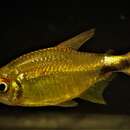en
names in breadcrumbs


Hemigrammus pulcher is a semi-popular aquarium species, also known as the pretty tetra, garnet tetra or black wedge tetra.[1] In the wild, the species is found near Iquitos in the Peruvian Amazon, and probably also in Brazil and Colombia.[1]
The H. pulcher has a pale-lemon background color with a black area on the flanks, up to the caudal penduncle.[2] Under subdued lighting, the H. pulcher's body appears iridescent.[2] It grows up to 4 cm. (1.5 in).[2]
Males can be distinguished from females through the shape of the swim bladder, which can be seen through the fish's semi-transparent body.[2] In males, the swim bladder is pointed, while in females, the swim bladder is rounded.[2]
Aquarists keep this fish in water with temperatures ranging from 23°C to 27° C (73°F to 81°F) that is soft (50-100mg/L) and acidic (pH 6.0).[2] The fish is reported to be peaceful and social.[2]
Aquarists recommend that it be fed prepared foods and small live foods.[2]
Breeding is difficult, as parents must be prevented from eating their own eggs. Eggs usually hatch within 20–24 hours.
The H. pulcher does best in groups of 6 or more.
Hemigrammus pulcher is a semi-popular aquarium species, also known as the pretty tetra, garnet tetra or black wedge tetra. In the wild, the species is found near Iquitos in the Peruvian Amazon, and probably also in Brazil and Colombia.